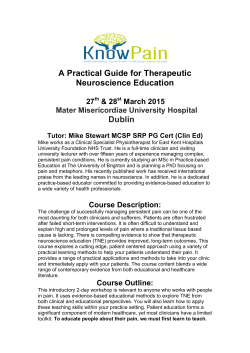
10 July 2015 NEUROECONOMICS AND FINANCIAL MANAGEMENT
LJUBLJANA DOCTORAL SUMMER SCHOOL 2015 6 – 10 July 2015 NEUROECONOMICS AND FINANCIAL MANAGEMENT ECTS credits: 6 Lecturers: Prof. Dr. Frank Hartmann, Rotterdam, School of Management, Erasmus University, The Netherlands Guest lecture contributions (TBA) Contacts: fhartmann@rsm.nl AIMS OF THE COURSE: Students understand both the actual and potential contributions that social cognitive neuroscience makes to financial management. COURSE SYLLABUS: 1. Topics in financial management Financial management: decision making and decision control Theoretical and practical issues in financial management Economic and psychological views on financial management 2. Brain anatomy and physiology The human brain: an introduction From neurons to brain networks and systems Introduction to EEG and fMRI analysis 3. Foundations of social cognitive neuroscience Alternative models of human behavior Consciousness and senses of agency Folk theories and biology 4. Financial management: Decision making Choice and decision making issues in financial management Rationality and bias Neuroscience studies on choice decision making 5. Financial management: Decision control Decision control issues in financial management Evaluation and reward Neuroscience studies on evaluation and reward LIST OF READINGS (PRELIMINARY): Aue, T., Lavelle, L., & Cacioppo, J. (2009). Great expectations: what can fMRI research tell us about psychological phenomena? International Journal of Psychophysiology, 73, 10-16. Bird, G., Silani, G., Brindley, R., White, S., Frith, U., & Singer, T. (2010). Empathic brain responses in insula are modulated by levels of alexithymia but not autism. Brain, 133(5), 1515-1525. Birnberg, J. G., & Ganguly, A. R. (2012). Is neuroaccounting waiting in the wings? An essay. Accounting, Organizations and Society, 37, 1-13. Camerer, C., Loewenstein, G., & Prelec, D. (2005). Neuroeconomics: How neuroscience can inform economics. Journal of Economic Literature, 43(1), 9-64. Chang, L. J., & Sanfey, A. G. (2013). Great expectations: Neural computations underlying the use of social norms in decision-making. Social Cognitive Affective Neuroscience 8, 277-284. Evans, J. (2008). Dual-processing accounts of reasoning, judgment, and social cognition. Annual Review of Psychology, 59, 255-278. Frink, D. D., & Klimoski, R. J. (2004). Advancing accountability theory and practice: Introduction to the human resource management review special edition. Human Resource Management Review, 14(1), 1-17. Fuster, J. M. (2001). The prefrontal cortex-an update: Time is of the essence. Neuron 30, 319-333. Gigerenzer, G., & Brighton, H. (2009). Homo Heuristicus: Why Biased Minds Make Better Inferences. Topics in Cognitive Science, 1, 107-143. Gonzalez, C., Dana J., Koshino, H., & Just, M. (2005). The framing effect and risky decisions: Examining cognitive functions with fMRI. Journal of Economic Psychology, 26, 1-20. Hartmann, F. G. H. (2000). The appropriateness of RAPM: toward the further development of theory. Accounting, organizations and society, 25, 451-482. Kahneman, D., & Tversky, A. (1979). Prospect theory: An analysis of decision under risk. Econometrica, 47(2), 263-291. Lerner, J. S., & Tetlock, P. E. (1999). Accounting for the effects of accountability. Psychological Bulletin, 125, 255-275. Oaksford, M., & Chater, N. (1995). Theories of reasoning and the computational explanation of everyday inference. Thinking and Reasoning 1(2), 121-152. Rilling, J. K., King-Casas, B., & Sanfey, A. G. (2008). The neurobiology of social decisionmaking. Current Opinion in Neurobiology, 18,159-165. Rizzolatti, G., & Fabbri-Destro, M. (2010). Mirror neurons: From discovery to autism. Experimental Brain Research, 200, 223-237. Santosuosso, A., & Bottalico, B. (2009). Neuroscience, accountability and individual boundaries. Frontiers in Human Neuroscience, 3, 45. Santiesteban, I., Banissy, M. J., Catmur, C., Bird, G. (2012). Enhancing social ability by stimulating the right temporoparietal junction. Current Biology, 22, 2274-2277. Tetlock, P. E. (1983). Accountability and complexity of thought. Journal of Personality and Social Psychology, 45, 74-83. TEACHING METHODS: The course consists of a mix of lectures, presentations and break-out assignments. The lectures and presentations are based on the reading material. A fMRI-lab visit is conditionally planned. PREREQUISITES: The course requires background knowledge in the field of financial management at the bachelor level. No prior knowledge on social cognitive neuroscience is supposed. EXAMINATION METHODS: The exam consists of a written essay that contains a short research proposal in financial management that uses theory and/or method from social cognitive neuroscience. The detailed form of the exam will be communicated in the first lecture. Lecturer’s Biographical Note: Frank Hartmann is full-time professor of Management Accounting & Management Control at the Rotterdam School of Management, Erasmus University. He is Dean of Executive Education in this school, besides which his main activities involve research and teaching on managerial decision making, and financial management and control. His research is published nationally and internationally in both academic and practitioner, and he teaches in the Dutch certified controller (MSc) program at Erasmus University, and in various MBA and executive programs at RSM and internationally. Frank is co-author of several national and international textbooks on management control, amongst which a recent standard textbook on Management Control Systems. He received his PhD at Maastricht University in 1997, after which he was appointed full professor at the University of Amsterdam in 1998. Here, he was founding director of the business school of that university before joining the Rotterdam School of Management, Erasmus University in 2005. Frank’s current work is in the neuroscience of financial decision making and performance evaluation. Frank is visiting scholar at various universities in Europe and abroad.
© Copyright 2025





















